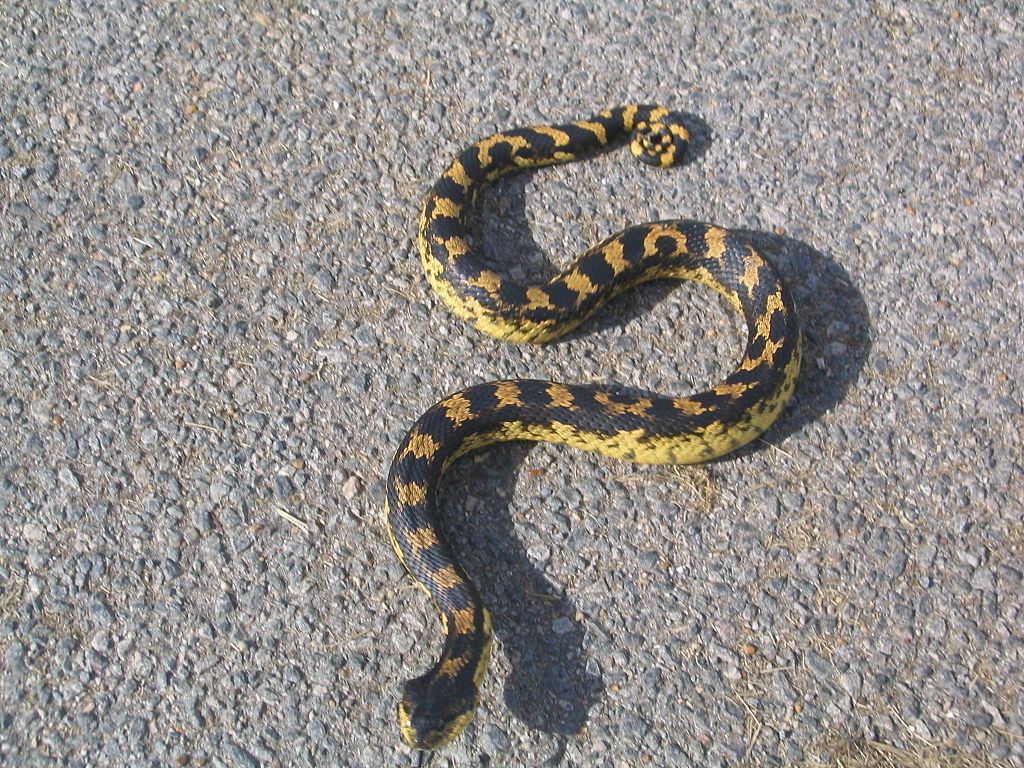
28 July 2014
If you’re afraid of snakes, please pretend this is a big “S” or close your eyes while you read.
I’m inspired to write about eastern hognose snakes today because summer is prime time for reptiles in Pennsylvania and a remark made in the PA Herps Facebook group has stuck with me since last winter: “The only way to get bitten by a hognose snake is to smell like its prey.”
The eastern hognose snake (Heterodon platirhinos) is native from Minnesota to southern New Hampshire, from Florida to eastern Texas. It is more than two feet long and comes in so many colors and patterns that it defies an easy description.
I imagine that during summer’s heat I might see a hognose snake but the chance is slim. I don’t look for snakes because I can’t identify most of them and some are poisonous. My caution prevents discovery.
However, this snake is safe. Very safe. He won’t bite but he may scare you. Wikipedia describes his defensive behavior:
When threatened, the neck is flattened and the head is raised off the ground, not unlike a cobra. [Cobra!!] They also hiss and will strike, but they do not attempt to bite. The result can be likened to a high speed head-butt. If this threat display does not work to deter a would-be predator, a hognose snake will often roll onto its back and play dead, going so far as to emit a foul musk from its cloaca and let its tongue hang out of its mouth.
— description of eastern hognose snake, wikipedia
If I managed to get close to a calm hognose I’d see why he has this name — an upturned nose like a hog.

But I’m not eager to get so close. If I scared him, the “cobra act” would frighten me. The “high speed head-butt” would certainly make me scream. Both the snake and I would be lolling on the ground with our tongues hanging out.
S is for Sometimes Scary.
p.s. Despite the tone of this article, I am not afraid of snakes.
(photo of an eastern hognose snake from Wikimedia Commons, Creative Commons license. I have horizontally flipped the original image to make an S. Click on the image to see the original at Wikimedia)
I rather like snakes. We used to catch garter snakes in our yard when we were kids and put them in coffee cans and try to get them to eat crickets. But then we’d let them go after a couple of hours. We probably caught the same snake multiple times and traumatized it.
I was on a hike with a group of botanical people a few years ago, when the hike leader asked us if we’d ever seen a rattle snake. A bunch of us said no, and he offered to find one for us… he did manage to find a timber rattler curled up in the middle of a clearing (which was kind of an odd place for it)… we formed a big circle about 10 feet away from it and were all taking pictures of it… it just sat there looking at us (might have been 4 to 5 ft long, uncurled). We saw a timber rattler last year curled up sleeping on a rock shelf…again, we were taking pictures, it didn’t care. We’ve come across any number of nonpoisonous snakes in our hikes (heck, we’ve had 3 to 4 foot rat snakes in our yard!), never had any problems.
The only time I’ve ever had a snake strike is when we removed a good size garter snake from our basement. We caught it in a tub and tossed it out on the driveway. It immediately tried to come back into the garage, and I took a long pole and kept flipping it away from the garage door, and it was striking the pole. It eventually decided it was in its best interest to go off into the woods.
We have been watching a garter snake in our yard which we think is pregnant. We were fascinated by the spots on the snake. I remember the garter snakes of my youth as being black with yellow stripes but this one also has some spots. My husband has been photographing the snake but we only see it on sunny mornings. Several years ago I stepped on a garter snake by mistake and it bit my sandal clad foot, leaving a tiny mark.
I think I had a heart attack just reading this, and am typing while laying on my back, with my tongue lolling out of my mouth.